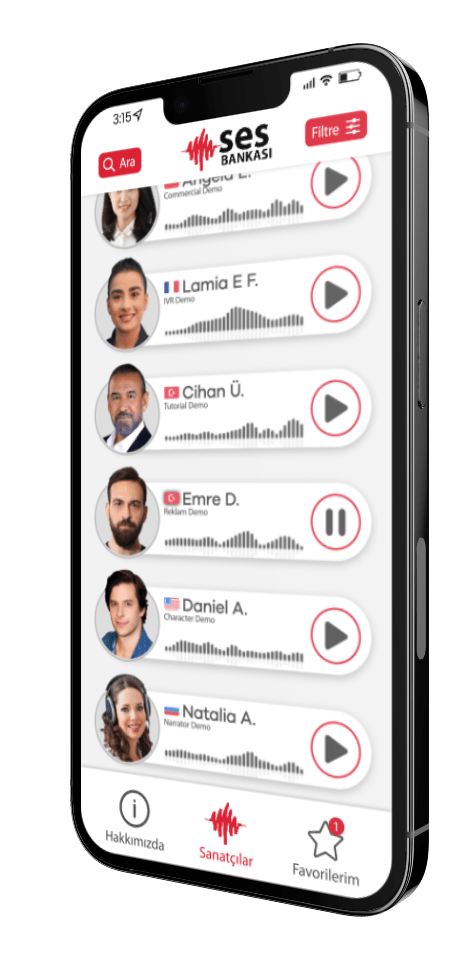What is Presentation Voice Over?
Presentation voiceover; It is the process of sounding the texts prepared for educational purposes in the form of powerpoint presentations and video presentations. Apart from these, promotional films are also in a kind of presentation category because they are often prepared step by step. Again, we can evaluate book voiceovers and e-learning voiceovers in this category.
In general, presentation voice-overs are needed by training and consultancy companies, and at this point, they get support by applying to a voice-over agency. According to the content of the presentation, the consulting firms first select the voice from the voice cast and the artist selected from the voice cast performs a pilot reading for the presentation. After the approval is given for the prepared pilot reading, the work begins.
What is Presentation Voice Over?
Presentation voice-over is a technique used to convey the content of a presentation through sound. This technique aims to convey the message to the audience more effectively by reading the texts used in the presentation in a professional manner. Presentation voice-over aims to attract the attention of the audience and enable them to better understand the content of the presentation by using an understandable and fluent tone of voice.
What are the points to be considered in presentation language and voice-over?
The language of expression in presentation texts should be simple and understandable, as in other voice-over texts. Direct topic-oriented explanations should be preferred, without making the sentences too long.
Apart from this, the thing to be decided in the presentation voiceovers is 'Will a script be written for the presentation?' , 'Do you need any additional comments?' or 'Will only the texts in the presentation be read?'. such details. Determining these details is necessary in order to make preparations such as putting it into text beforehand, if there will be a narrative other than the texts in the presentation.
Apart from these, we can mention a few points to be considered during the voice over;
Intonation and Melody: Presentation voiceovers do not need a theatrical reading or emotion as in commercial voiceovers. It has a more narrative style, but there should be a change in tone and melody while reading so that it is fluent and does not bore the listener. Because presentations generally have a straight and long text structure, a straight reading will bore the audience in a few minutes. Therefore, when voicing for a presentation, decide which words and passages will receive more attention and increase the tone of emphasizing these points. But this should be done naturally! If something sounds exaggerated or wrong, it will annoy your audience.
Volume: Considering that the goal is to be heard and trusted by the audience, it is important to speak in a way that everyone can understand. So to draw the listener's attention to certain parts of a speech, try changing the volume—sometimes louder, sometimes softer—and make sure the selected transitions are separate from the others. Speaking in front of the microphone doesn't always require you to speak in a low voice. In situations where you want to increase the volume, it is preferable to keep yourself slightly away from the microphone and speak louder than usual. Speech is not ordinary speech and if the words are delivered softly, the voice actor will not be able to convey the desired passion and enthusiasm.
Openness: It is necessary not to neglect to express each word clearly in order to ensure clarity and for the audience to understand.
Emphasis: Even in the same sentence, emphasizing different words can change the focus of a message. Look: “I went to that supplier's office,” “I went to that supplier's office,” “I went to that supplier's office,” “I went to that supplier's office.” Even though the sentences are the same, what is meant changes with the emphasis. That is, changing the emphasis can change the meaning or implication.
pauses: According to renowned presenter Carmen Taran, when pauses are placed at strategic points in a speech, they can make the difference between a good and a great presentation. There are several purposes for which pauses can be used: to give listeners a chance to process something that has just been said; forming expectations about something to be said; giving the presenter a chance to think about what will be said next; ensuring the presenter is breathing properly; and even giving the presenter time to think before answering a particular question. Using this method, which should be used while making a presentation, will also provide the same effects when making a presentation voice-over.
Progress speed: If a presentation is dubbed over too quickly, it may make it difficult to understand and create anxiety in the viewer/listener. If it is sent too slowly, it may tire and bore people. Therefore, progress should be made at a natural pace.
Ton: There must be consistency between the tone of the voiceover and the content conveyed. No one can prove their power by speaking in a soft tone of voice or show that they are in control of the situation by using a desperate tone. So make sure you internalize the content of the presentation, check if it is consistent with the text, then set the right tone for that speech or part of the speech.
Remember to follow these 7 tips when using your voice for presentations. Afterwards, we guarantee you'll get a better performance, a better presentation overall, and a more enthusiastic audience.
How to Make a Presentation Voiceover?
When giving a presentation voice-over, you can ensure an effective presentation experience by following the steps below:
- Prepare the Text in Advance: Prepare the text you will use in your presentation in advance. The text should be clear, understandable and fluent. Be careful to use a language that your target audience can understand.
- Record Your Voice: Record your voice reading the text professionally. When recording sound, make sure your microphone is of good quality and the environment is quiet. Let the sound be heard clearly and cleanly.
- Intonation and Emphasis: Use intonations and emphasis appropriate to the content of your presentation. Make sure the message is better understood by emphasizing important points. Enhance the flow of your presentation by changing your tone and pace.
- Diction and Speed: Pay attention to your diction and pronounce words correctly. Be careful to speak clearly and fluently. Also, keep the pace of the presentation under control so that the audience can follow the text.
- Target Listeners: When giving a presentation, do not forget to address the audience. Shape the voice-over by taking their needs and expectations into consideration. Capture the audience's attention and communicate effectively by using an engaging tone of voice.
- Process Audio Recording Well: Make mistakes and corrections by listening to your audio recording. Improve the quality of the audio by making necessary edits and optimize the recording for the best result.
Presentation voice-over is an important way to increase the impact of your presentation. A professional voice actor You can attract the attention of the audience, convey your message better and make the presentation experience more effective. You can perfect your presentation voice-over with good preparation, correct emphasis and fluent diction.
PRESENTATION VOICE OVER IN TURKEY
Voice-over agencies, which meet the great need for voice presentation in universities, prepare voice presentations on different subjects in the field of education. The service in question here isold book voiceover not; It is a more specific area.
These prepared audio presentations are made within the scope of presentation voice-over and guide millions of people. However, just as not every commercial voiceover or dubbing person can do presentation voiceovers, a person who does presentation voiceovers is not expected to do other work. For this reason, it would be good if the voice actor to be worked with has experience in presentation voice-over.
The number of voice-over agencies that make presentations in Turkey is quite low. BiberSA Production, which meets an important need in Turkey in the field of presentation dubbing, has been providing presentation voice-over services on various subjects to training and consultancy companies for a long time. You can also reach BiberSA Production for the projects you need voice over.



















